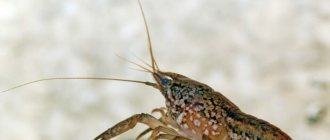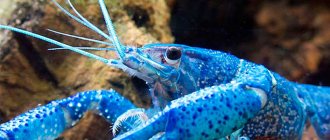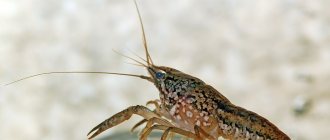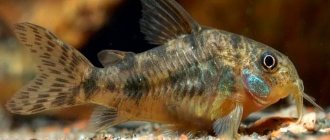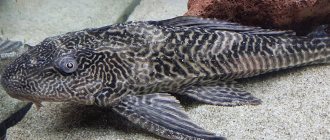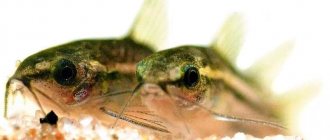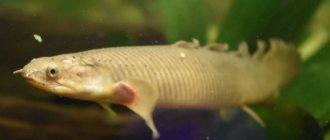Large crustaceans can be seen more and more often in aquariums. First of all, this is due to its unpretentiousness in feeding and care. At the same time, crayfish have good decorative qualities. There is a certain zest in the content of these aquariums. tenants. California crayfish is one of the brightest representatives of crustaceans, which often becomes the choice of beginning aquarists. More details about the content of California cancer will be discussed in this article.
California crayfish
Description
California crayfish has several names. To some people it is known as Vietnamese or Florida cancer. In any case, it is the same animal. It is a freshwater representative of decapod crayfish. The California crayfish lives in the swamps of the southeastern United States. In the early 70s, this crustacean began to be grown at home.
California crayfish has several names
The peculiarity of the Florida crayfish is its ease of feeding and maintenance. You need to put a minimum of effort into growing, but in turn, crustaceans will decorate your home aquarium . In addition, the cancer has a fairly bright color. Its body has a rich red color. It is simply impossible to pass by the aquarium where the California crayfish lives, and not stop at least for a few seconds to admire it.
Note! The color of the California crayfish depends on feeding habits. If carotenoids are present in the food, the animal will have a bright red color. Regularly feeding the crayfish mussels can change its color to blue.
Breeding
By the age of two, the cancer reaches sexual maturity. Spawning can take place both in a separate and in a common aquarium. The female carries about 200 eggs on the inside of her abdomen for 4-5 weeks, of which only about 30 crustaceans survive. If the female tries to climb to the surface, using aquarium plants as an aid, and turns her abdomen on her side, then this indicates a lack of oxygen, which can have a detrimental effect on future offspring. A female Florida crayfish can brood eggs up to 3-4 times a year. Due to its elegant glowing red color and incredibly easy reproduction, this type of shrimp has the same popularity as Crystal Red and today it is one of the most common types of dwarf shrimp. Red fire shrimp were recently imported from Taiwan, and their appearance was a real shrimp boom.
BLUE CUBAN CRASH (PROCAMBARUS CUBENSIS) IN THE AQUARIUM
What does a crustacean look like?
This is a relatively small animal, the maximum size of which reaches 20 cm. But this is only in the wild, since in an aquarium the crayfish does not grow more than 12 cm. The body of the Florida crayfish consists of the abdomen and the cephalothorax . The abdomen ends in a caudal fin . The walking legs of the crayfish are attached to the first section, in principle, like in other types of crustaceans. The last pair of legs are strong claws. The functions of the sense organs are performed by special antennas and eyes.
What does California cancer look like?
The color of the California crayfish can vary from brown to purple or blue. But the most common ones are red ones. As noted earlier, the color of a crustacean is greatly influenced by the composition of its diet. The body of blue crayfish can be decorated with small yellow spines. Red individuals have white spines. The powerful claws are also decorated with characteristic spots, the color of which may change over time. This is the peculiarity of the appearance of Florida crayfish - they can be different depending on certain factors.
Diseases of aquarium crayfish
Many diseases of aquarium crayfish are associated with unfavorable living conditions. High levels of nitrates in water can lead to illness and death of crayfish. Infectious diseases are characterized by a decrease in fertility and death of the population. The most dangerous are: crayfish plague, rusty spot disease and porcelain disease. Treatments against these diseases have not yet been developed.
Crayfish plague (Pestis astacorum, Aphanomices astaci) is an acute infectious disease caused by the fungus Aphanomices astaci. Crayfish of all ages are susceptible to infection. The pathogen can be transmitted through waterfowl and fishing gear. One sick cancer can infect the entire aquarium and cause the complete death of all its inhabitants. Plague-infected crayfish can be identified by white or brownish-red spots on the tail muscles, as well as black spots on the shell.
Changes are also noted in the behavior of crayfish: usually leading a nocturnal lifestyle, crayfish are active during the day, trying to get out, the “gait” becomes similar to walking on stilts, with noticeable signs of disorientation. They move relying on their outstretched limbs and the end of their tail. Then lethargy and limb cramps are noted. In the late stage, the crayfish stop moving, fall over on their backs, their limbs cramp, and the crayfish die.
No treatment has been developed. Prevention comes down to quarantining newly acquired crayfish. Fungal spores are sensitive to high and low temperatures and die after 30 hours in water with a temperature of 30° C. Malachite green and magnesium chloride (bischofite) help reduce sporulation.
Rust spot disease or Septocylindrosis (Mycosis astacorum) is an infectious disease of crayfish caused by various types of fungi of the family. Mucedinaceae. Fungi reproduce by conidia. The source of the causative agent of the disease is sick crayfish (mainly their corpses and shells discarded after molting).
Infection occurs by eating infested lower crustaceans or direct contact of fungal conidia on the shell. Infection is facilitated by unfavorable living conditions for crayfish. Rust spot disease manifests itself as rusty orange, dark brown or black spots of varying sizes on the body of crayfish, and ulcers form in areas where the muscles are affected.
It happens that in infected cancer the ulcers scar, forming a chitinous tubercle. But fresh ulcers appear in other places. Brownish or golden-yellow seals also form in the liver of sick cancers. The fertility of crayfish decreases, and crayfish die slowly. No treatment has been developed. Prevention is the same as for crayfish plague - quarantine of newly acquired crayfish for 3-4 weeks. It will be useful to add dried beech, oak or almond leaves to the aquarium.
Porcelain disease or Thelochanosis is an invasive disease of crayfish caused by the sporozoan Thelochania conteyeani, with characteristic damage to the muscles of the mouth, abdomen and limbs. Microsporidia penetrate the muscles of the abdomen, legs and mouth. In sick crayfish, the lower part of the abdomen becomes white. After infection with microsporidia of the fungus, the muscles of the legs, abdomen, and mouthparts lose mobility and the paralyzed cancer dies. Infection occurs through contact with a sick animal. Treatment and prevention have not been developed.
Where does it live?
When considering the natural habitat of the California crayfish, it is worth noting the southeastern part of the United States and the northern part of Mexico. The species was artificially acclimatized in continents such as Asia and Europe. Over time, the cancer managed to displace other species of river crustaceans, which were more sensitive to the quality of water in reservoirs.
The usual habitat of the California crayfish is marshy areas.
The usual habitat of the California crayfish is marshy areas (lakes, rivers and ponds). During the drought period, crayfish are able to burrow deep into the ground , and after it is over, return to their normal lifestyle.
Content Features
Experts recommend keeping California crayfish in an aquarium in pairs or individually. This applies to mature individuals, since younger crustaceans can be housed in small groups. Of course, the likelihood of conflicts will increase.
How to keep California crayfish
On a note! One California crayfish requires an aquarium with a volume of at least 70 liters.
When designing an aquarium, special attention should be paid to the bottom area. This is not surprising, because this is where crayfish spend most of their time. It is recommended to use small river pebbles when laying the soil. Sand is out of the question, since Florida crayfish often dig up the soil, thereby raising a lot of sand and dirt. To prevent the water from being constantly cloudy , it is advisable to avoid using sand.
It is better not to put sand on the bottom
Feeding
It's time to discuss another important issue. What does aquarium crayfish eat? Under natural conditions, the basis of their diet is mainly plant foods. In the aquarium they are fed sinking pellets, flakes and special foods. It is advisable to choose food for crayfish that has a high calcium content. It will help restore the chitinous cover faster. Additionally, they can be given vegetables: spinach, zucchini, cucumbers.
Aquarium crayfish will not refuse protein foods, but they should be given no more than once a week. A piece of shrimp or fish fillet or special frozen live food is suitable for this. Experienced aquarists believe that protein foods significantly increase aggressiveness.
You should feed the crayfish once a day, but vegetables can be left until the crayfish eat them.
Requirements for an aquarium
One of the main components of an aquarium for crustaceans is the presence of sufficient hiding places . Animals love to hide in them, this is especially true during the molting , when crayfish are most vulnerable. You can use various ceramic pots, coconut halves, or small driftwood as shelters. But at the same time, it is important to close all technological holes that are in the aquarium design. Otherwise, the crayfish may escape through them.
Requirements for an aquarium
It is imperative to equip the aquarium with a special filter and water aeration . This is especially important in the summer. Aeration should be around the clock. It is important. Without providing optimal conditions, crustaceans in the aquarium will not be able to fully develop.
It is important to ensure good aeration
Reproduction
When mating, the female turns over on her back, and the male California crayfish fertilizes her, holding her in this position with his claws. 3 weeks after fertilization, the female lays about two hundred eggs . Due to the active movement of the caudal fin, the female ensures constant ventilation of the eggs, which are attached to her swimming legs. During this period, it is advisable to move the female into a separate container filled with the same shelters in the form of driftwood. It is necessary to place food near the female’s shelter.
Reproduction of California crayfish
The duration of the incubation period is 30 days, after which tiny crustaceans no more than 7-8 mm long appear from small eggs. And if at first the crustaceans should be close to their mother, then over time her parental instincts will gradually begin to fade away. It is important not to miss this moment and transfer the small crustaceans to another tank in time. Otherwise, the female may simply eat them.
Cancer Californian
Useful video
Check out this interesting video about aquarium crayfish:
However, for comfortable maintenance of arthropods, it is necessary to create conditions as close as possible to the natural environment. It is also important to know which crayfish are suitable for keeping with fish, and which are better kept separately. Previous
InhabitantsCreating the necessary conditions for aquarium shrimp
Next
InhabitantsTurtle from the Red Book - European swamp
Shedding
From time to time, aquarists when raising crayfish encounter such a phenomenon as molting . This is a special stage in the life of crustaceans, during which the old protective shell is shed. This happens because the cancer cannot grow in the old integument and needs a new one, but a larger one. Immediately after shedding their shell, crayfish become very vulnerable - they can be attacked by other aquarium inhabitants. Crayfish can also be damaged by decorative elements.
About molting in crayfish
The frequency of molting can be influenced by various factors, such as the composition of the food, the age of the crustacean or the frequency of feeding. After the cancer sheds its old shell, you don’t have to worry about it, because after a while the cancer will get rid of it on its own (it will eat the shed chitin coating).
Lifestyle
Crustacean animals, including the lobster, the mantis crab, and the hermit crab, are both large and small within their family and species. Many of these animals are able to camouflage perfectly, radically changing their color to match the color of the surrounding ground, for example, the blue lobster. As mentioned above, while some crayfish run, swim and climb everywhere, others prefer a passive lifestyle, attaching themselves to certain underwater objects.
Many crustacean creatures protect themselves from enemies with the help of calcareous shells, but not all have this ability. For example, the large sea crayfish lobster, as well as shrimp and crabs, do not have shells at all. Their body is covered with a reliable shell consisting of durable chitinous plates. The familiar crayfish also have such shells.
Compatibility with other types
If you don’t know whether California crayfish can be kept with other aquarium inhabitants, then the answer is yes. A well-fed crayfish will not attack fish, but if there is not enough food in the aquarium, then a hungry animal may well attack a small fish. It is not recommended to keep fish with wide veil fins together with crayfish. Crustaceans can damage them.
Is it possible to keep California crayfish with other aquarium inhabitants?
Fish are more nimble, so they will eat food in the aquarium faster. Therefore, you need to be sure that the crayfish are getting enough food. Molting has already been mentioned before. So, some types of fish can attack defenseless crayfish that have just gotten rid of their shell. This is why it is so important that there is a sufficient number of hiding places at the bottom of the aquarium.
Crayfish need to be provided with enough food
When considering the most suitable neighbors for California crayfish, it is worth highlighting gourami, barbs and mollies. You can also introduce Malawian cichlids into the aquarium, but their behavior must be controlled during the molting period. The rest of the time, the fish get along well with almost seven species of crustaceans.
TOP 11 unpretentious aquarium fish TOP 10 largest aquarium fish TOP 20 beautiful aquarium fish TOP 12 most expensive aquarium fish
See also : Florida blue crayfish in the aquarium: description, photo, character and content. In addition, you will probably be interested in the article about the Fiza snail.
Nutrition
The Florida crayfish is omnivorous. With equal appetite, it eats pieces of fish, meat, squid, bloodworms, carrots, shrimp, coretra, tubifex, sinking dry plates and tablets. At the bottom there should always be leaves of oak, maple, birch, walnut or Indian almond. Plant nutrition consists of lettuce, spinach, cabbage leaves and dandelion. In small quantities, you can give millet, rice and pearl barley porridge, cooked only in water. They enjoy eating snails along with their shells.
